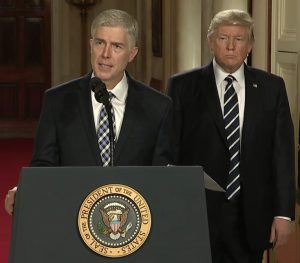Bench for life: Term limits needed for Supreme Court justices
October 17, 2018
Monarchs rule for life and so do Supreme Court Justices. The ongoing drama and intense scrutiny surrounding the Senate Judiciary hearing on Judge Brett Kavanaugh’s nomination to the Supreme Court has resurfaced the question as to whether there should there be a term limit for the Supreme Court justices.
This is probably one of the few offices in the world where you are guaranteed work for life. In the recent years, the average number of years a judge has served in office has gone up from 16 to 26. With younger judges now serving for almost three decades, the appointment to the highest court in the country has become a high stakes affair. 61% of the registered voters expressed support for a term limit on Supreme Court Justices according to National Tracking Poll #180724 conducted in July 2018.
America is the only democracy in the world which grants the federal judges lifetime tenure to their offices. The Supreme Court justices are nominated by the President and confirmed by the Senate. This process differs significantly from other major democracies in the world. In the United Kingdom, Judges of the Supreme Court are appointed by The Queen on the recommendation by a special selection commission and are required to retire by the age of 70 while in India the Supreme Court justices are appointed by the President based on the recommendations of a committee comprised of the Chief Justice of India and five senior judges of the court with a retirement age of 65.
The Supreme Court of the U.S. decides on the interpretation of the written Constitution. With the lifetime appointment, the framers of the Constitution wanted to ensure that the judiciary branch would remain independent of the legislative and executive branches. But I think the intention to keep the judges free of re-election pressure and the need for popular votes has long been lost.
Our founding fathers must be anguished at the current state of the political affairs where an empty supreme court seat was used as a 2016 election tool by both the parties and the nomination process of Judge Kavanaugh became a further display of partisan divide.
The citizens watched Judge Kavanaugh officially appointed as the 114th Supreme Court justice for life in an emotional, controversial, and partisan process by a 50-48 vote.
The appointment of Supreme Court justices will continue to remain a contentious issue in the near future, since any changes to the Constitution have to be approved by the Congress and ratified by ¾ of the States.
This is a daunting task. Yet I hope that by some miracle, we can set term limits and a mandatory retirement age for the Supreme Court justices to restore integrity to this highly privileged position.
This piece was originally published in the pages of The Winged Post on Oct. 17, 2018.


















![“[Building nerf blasters] became this outlet of creativity for me that hasn't been matched by anything else. The process [of] making a build complete to your desire is such a painstakingly difficult process, but I've had to learn from [the skills needed from] soldering to proper painting. There's so many different options for everything, if you think about it, it exists. The best part is [that] if it doesn't exist, you can build it yourself," Ishaan Parate said.](https://harkeraquila.com/wp-content/uploads/2022/08/DSC_8149-900x604.jpg)




![“When I came into high school, I was ready to be a follower. But DECA was a game changer for me. It helped me overcome my fear of public speaking, and it's played such a major role in who I've become today. To be able to successfully lead a chapter of 150 students, an officer team and be one of the upperclassmen I once really admired is something I'm [really] proud of,” Anvitha Tummala ('21) said.](https://harkeraquila.com/wp-content/uploads/2021/07/Screen-Shot-2021-07-25-at-9.50.05-AM-900x594.png)







![“I think getting up in the morning and having a sense of purpose [is exciting]. I think without a certain amount of drive, life is kind of obsolete and mundane, and I think having that every single day is what makes each day unique and kind of makes life exciting,” Neymika Jain (12) said.](https://harkeraquila.com/wp-content/uploads/2017/06/Screen-Shot-2017-06-03-at-4.54.16-PM.png)








![“My slogan is ‘slow feet, don’t eat, and I’m hungry.’ You need to run fast to get where you are–you aren't going to get those championships if you aren't fast,” Angel Cervantes (12) said. “I want to do well in school on my tests and in track and win championships for my team. I live by that, [and] I can do that anywhere: in the classroom or on the field.”](https://harkeraquila.com/wp-content/uploads/2018/06/DSC5146-900x601.jpg)
![“[Volleyball has] taught me how to fall correctly, and another thing it taught is that you don’t have to be the best at something to be good at it. If you just hit the ball in a smart way, then it still scores points and you’re good at it. You could be a background player and still make a much bigger impact on the team than you would think,” Anya Gert (’20) said.](https://harkeraquila.com/wp-content/uploads/2020/06/AnnaGert_JinTuan_HoHPhotoEdited-600x900.jpeg)

![“I'm not nearly there yet, but [my confidence has] definitely been getting better since I was pretty shy and timid coming into Harker my freshman year. I know that there's a lot of people that are really confident in what they do, and I really admire them. Everyone's so driven and that has really pushed me to kind of try to find my own place in high school and be more confident,” Alyssa Huang (’20) said.](https://harkeraquila.com/wp-content/uploads/2020/06/AlyssaHuang_EmilyChen_HoHPhoto-900x749.jpeg)














